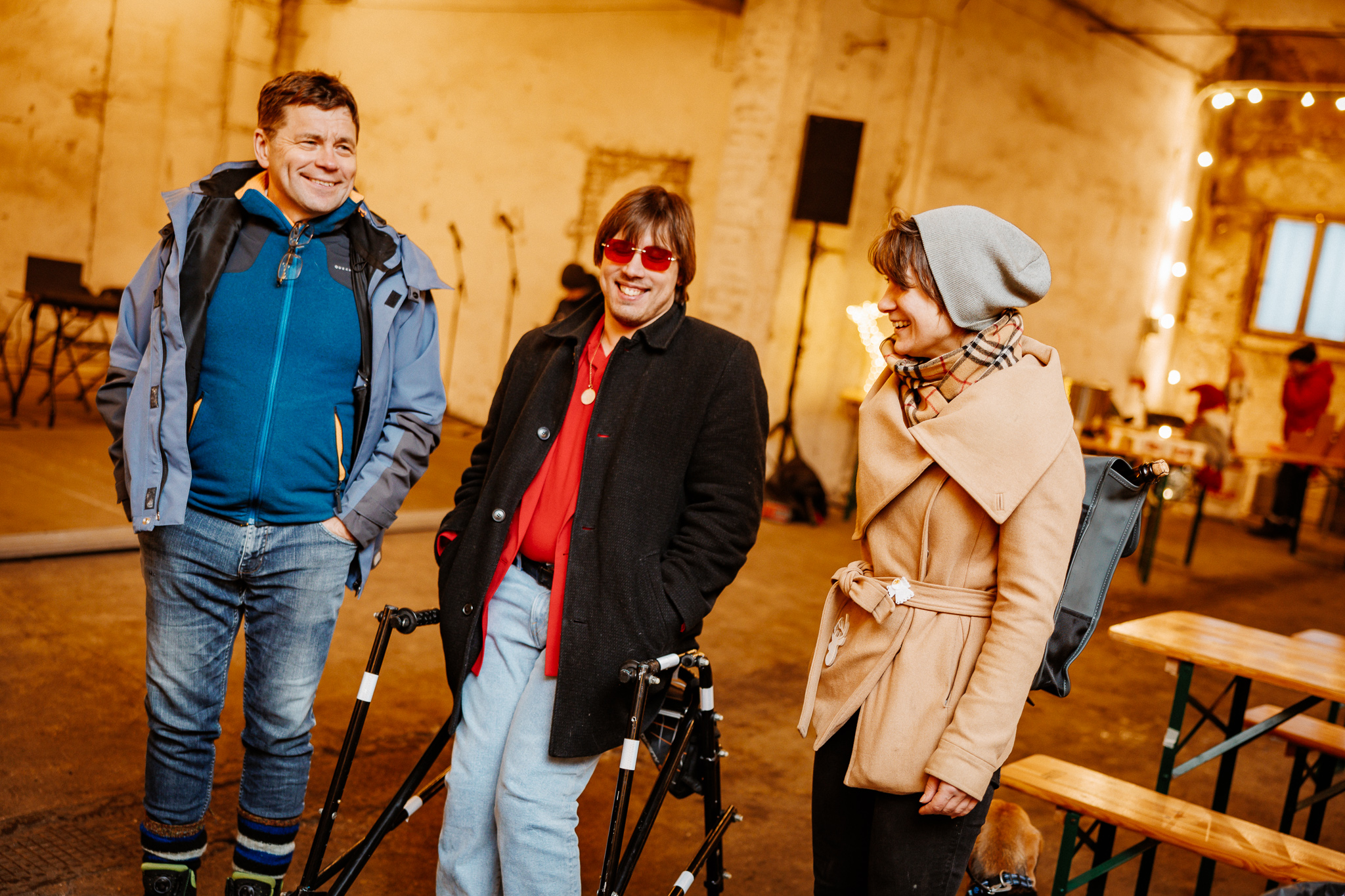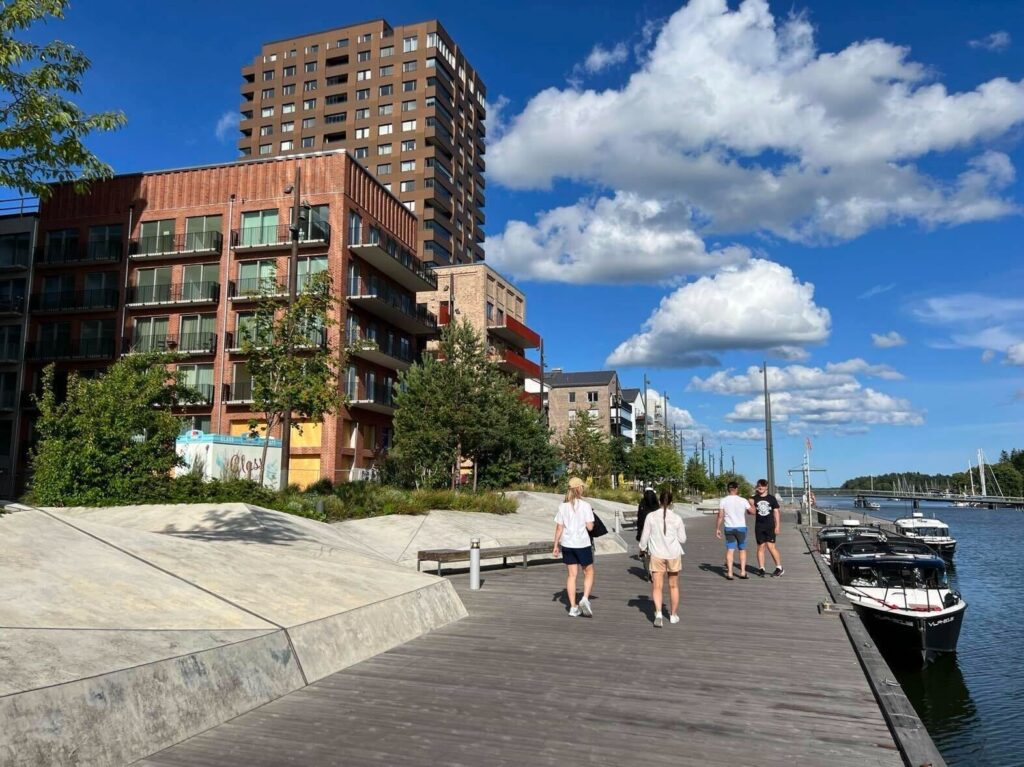In the pursuit of a people-centric city, starting with the 8-80 principle should be fundamental. This principle envisions streets that are safe, accessible, and enjoyable for both 8- and 80-year-olds, ensuring inclusivity for all.
By weaving the needs and preferences of both younger and older demographics into the city’s design, it naturally becomes more inviting and user-friendly for everyone. Following the principles of universal design guarantees the comfortable use of products and the environment for all members of society, including those with disabilities.
“Universal design’s essence lies in its ability to cater to as many groups as possible without requiring special solutions,” explains Kristo-Adam Priks, a leader at the NGO Accessibility Forum (MTÜ Ligipääsetavuse Foorum). “The environment should be usable for as many people as possible throughout their lives – whether you’re pushing a stroller or relying on a walking frame,” Priks emphasises.
A longer conversation with Kristo-Adam Priks and Villu Urban, leaders of the NGO Accessibility Forum, delved into the topic of creating an accessible urban space.
Accessibility Affects Us All
In Estonia, 8.7% of the total population has disabilities, with a significant portion of those over 64 years old having special needs (56%). 1 “Understanding that everything you do will eventually impact you is crucial,” emphasises Priks. It’s at the core of the matter.
An intriguing observation is that when steps and ramps are both available, most people opt for the more comfortable sloping surface. This demonstrates that ramps are not only essential for individuals with disabilities but serve as a universal element, suitable for those with strollers, luggage, and more. 2.
Using plain language is also a win-win – clear and understandable information is crucial for individuals with intellectual disabilities, making life simpler for everyone.
Challenging conventional perceptions, Priks notes, “The most common image of a disabled person is someone in a wheelchair – they have needs, and there’s a law requiring ramps. In reality, everyone has similar needs; people’s requirements change over their lifetimes, and there’s substantial overlap between different groups.”
Prisoners of Poor Planning
In Estonia today, a significant accessibility challenge lies in the Soviet-era housing, often referred to as our “red heritage.” During this period, Estonia’s most populous districts – Õismäe, Lasnamäe, and Mustamäe – were constructed.
Elevator requirements at the time only mandated installation for buildings exceeding five stories. Consequently, typical five-story buildings usually lacked elevators. Paradoxically, in nine-story buildings with elevators, accessibility often started from the first mezzanine floor, requiring additional effort to reach.
Unfortunately, it is no exaggeration to say that a large percentage of people with mobility problems are trapped in their homes, according to NGO Accessibility Forum leaders. “It’s quite alarming and needs immediate attention,” stresses Urban.
Regrettably, the construction of such buildings, where the elevator starts at a higher level, continues.Years have passed since the Soviet era, but the legislation has not changed much – now a lift is only mandatory if the building has four floors. 3. Many schools, kindergartens, and shops have been built with similar flawed logic
North America and Japan excel in physical accessibility, notes Priks, while southern Europe and other Asian countries show good accessibility in resort areas but decline as you move away from the centre. Attitudes toward accessibility also vary by culture; in Asia, the assumption is that individuals with disabilities will always have a companion, minimising emphasis on the physical environment.
In Tallinn, examples like the Seaplane Harbour, Estonian Maritime Museum, Fat Margaret, and Maarjamäe Memorial are cited as instances where efforts have been made to enhance accessibility.
Money Talks
Integrating the 8-80 principles into urban planning not only enhances residents’ quality of life but also fosters healthier, more vibrant, and inclusive communities, meeting the needs of all, regardless of age or ability.
The quickest adoption of accessibility, Priks notes, occurred with the rise of commerce. In the mid-nineties, the Western shopping centre model, designed for smooth movement with large shopping carts, was introduced. As shopping carts, wheelchairs, and strollers have relatively similar mobility needs, accessibility in this area naturally evolved. “People fight for customers. Anything that helps in that regard is generally accepted,” admits Priks.
Fortunately, people now know how to ask a developer for an accessible building, and it sells. Simply explaining that a key employee in a leg cast could return to work sooner with an accommodating approach makes a compelling case. “Everything has to be seen in this light,” says Priks.
Viewing accessibility as an opportunity, a gain, and a saving, not just a law to be enforced, is crucial.
Attention to accessibility should be self-evident and become a natural part of design and planning. Accessibility need not compromise design; instead, it becomes an architectural solution, seamlessly blending functionality with aesthetics.
Accessibility requirements can often be met through interior design alone – for instance, the first and last steps of a staircase need not be marked with black and yellow stripes but can align with the overall colour scheme. The key is functionality.
Design elements such as signs and inscriptions can incorporate relief, offering tactile guidance for people with visual impairments.
Don’t Put Off Until Tomorrow What You Can Do Today
Urban emphasises the importance of considering accessibility from the outset.
Focusing on creating smooth movement paths, lifts, and elevators for vertical access is crucial. Retrofitting ramps later, without this initial focus, can create inconvenience for everyone. “At the start of the planning process, consider how to create relief so that movement flows smoothly,” advises Urban.
Approaching planning in a complex way, rather than piece by piece, enables a broader assessment of whether the built environment is easy to navigate, good, safe, logical for movement, and functionally coherent.
“It’s also a myth that accessibility is expensive,” adds Priks. According to Urban, the cost difference between designing an accessible building and a non-accessible one is negligible. Additional costs may only arise for special solutions requiring equipment purchase.
NGO Accessibility Forum managers highlight that significant resources are often allocated to less critical aspects. They cite an example of a restaurant where owners claimed financial incapacity to build an accessible toilet but invested in an extravagant row of expensive wooden benches – likely equivalent in value to the cost of the toilet.
Ideally, individuals should maintain self-sufficiency for as long as possible, remaining active in the labour market. However, global ageing trends indicate a shrinking working-age population, leading to a surge in social care costs. Inaccessibility, therefore, poses a considerable economic burden to the country, especially as improvements tend to be incremental rather than through comprehensive solutions.
Estonian Railways serves as a positive example, having renovated all stations and acquired trains compatible with platforms, resulting in virtually no inaccessible platforms. “This is how things should be solved in Estonia – simultaneously,” states Urban.
Equal Rights
Accessibility extends beyond physical spaces; it encompasses participation in community life, cultural events, and social activities. In an accessible urban space, whether it’s a government office, cinema, park, or bottle bank, everyone should have safe and comfortable access.
“Inaccessibility is somewhat like a mental state,” explains Urban. If individuals in wheelchairs must seek assistance each time they wish to go somewhere, there comes a point when the desire to venture out diminishes. “If there’s no alternative, eventually, I’ll stop trying.”
With the future Hundipea envisioned as a mixed-use space with a diverse population, creating an accessible urban environment is a paramount goal. While Hundipea will evolve over decades, the community is already collaborating to find interim uses for the site.
At our warehouse, we are increasingly hosting events, making the current activation accessible to everyone. This presents an excellent opportunity for self-education, learning the best accessibility solutions and applying this knowledge to the planning of an entire urban district.
The conversation with representatives of the NGO Accessibility Forum marked the initiation of our journey to craft an exemplary accessible urban space in Hundipea. While the initial discussion revolved around the challenge of making the first public warehouse in our area accessible, it swiftly expanded to encompass broader topics and areas of study.


